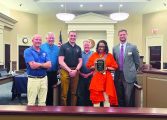By Pat Wilson
Correspondent
The slogan took on a new meaning as Pat Willis spoke to green-thumb enthusiasts on a Saturday in March. Her topic was Annuals and Perennials: What Makes Your Garden Smile. The retired landscaper and master gardener led the Backyard Gardening Seminar as part of the programs sponsored by Louisa Extension Master Gardeners, a group under the auspices of the local Virginia Cooperative Extension Services.
Starting with basic information, Willis distinguished between annuals, plants that complete their life cycles in one season, and perennials, plants that survive for more than one season. Perennials can have varying life cycles, with peonies being one of the longest lasting, according to Willis. She emphasized that there are exceptions, since plants that are annuals here might be perennials in warmer climates. The quality and length of light is most vital to plant sustainability.
“We live 38 degrees north of the equator and that means as the seasons changes, the length of our days changes,” she said. “In June we have approximately 14.5 hours of sunlight, while in December we have less than nine hours. Plants need sunlight to grow and produce chlorophyll, which takes in carbon dioxide and give off oxygen.”
The zone designation means that the local climate averages approximately 180 frost-free growing days from mid-April to late September. More importantly, according to Willis, is this relationship to soil temperature which needs to be at least 50 degrees for root growth. The group laughed when she quoted an old wives’ tale, “Don’t plant tomatoes until you can sit on the ground bare-bottomed for two minutes.” The master gardener then offered more practical tips, starting with soil preparation.
Willis encouraged having soil tested every two to three years. Virginia Tech offers the service for a small charge and the local office can supply collection boxes with instructions. Having the correct pH and knowing which fertilizers, if any, are needed to provide the correct nutrient balance for the type of plant will help ensure success. Commercial fertilizers, as well as compost, can aid the soil.
“Fertilizers use the letters NPK for nitrogen, phosphorous and potassium. The numbers on the package are important. Nitrogen [N] promotes greener leaves,” she said. “High amounts of phosphorous [P] will benefit annuals and fruits, while high potassium [K] will benefit roots and stems, so it is good for perennials. Proper fertilizing requires using water to soak it into the ground after scattering it around the drip line. Leaving fertilizer on dry soil is a waste of time and money.”
In the piedmont zone, the soil retains water more efficiently than in sandy or alkaline soils. So, Willis encouraged plant selection and placement to match the soil or enhancing the soil to meet plant requirements. Routine watering should soak in at least three inches. Early morning or evening watering is ideal, but Willis recommended watering “when convenient as long as it is deep enough and long enough.” Don’t overwater! Some plants, like impatiens, naturally droop in the heat of the day, but revive as the day cools.
Be vigilant when choosing plants. At least 90 percent of the plants purchased locally are grown commercially out of the zone and trucked in. Gardeners should either seek out area nurseries that grow their own plants or start seeds for themselves. Flowers started from seed, especially ones like zinnias and marigolds, will mature at about the same rate as bedding plants.
“This allows you a better selection of what you want and not what a commercial grower thinks will sell during a particular year,” she said, then cautioned, “Commercial operators use growth regulators to make bedding plants in a six-pack look similar, and light, dry bedding mixtures to save shipping costs. Since chemicals might be present, it is best to shake that mixture from the roots then separate the roots before planting.”
Willis reviewed handouts that described numerous annuals and perennials, as well as their hardiness, temperature and sunlight preferences, and maintenance levels. Some purchased plants might do better if they are “hardened,” a term she used to describe taking new plants outside in the warmth for a few hours each day, then lengthening the time over a week or so to allow them to adjust to the weather. Willis admitted a gardener must be truly dedicated to do this.
As a member of the Charlottesville Native Plant Society and Louisa County Historical Society Herb Guild, Willis said not to forget those options. Similar selection information is available at the Louisa Extension Service offices, along with various websites. Master gardeners will offer advice at a Mineral Farmers Market booth on Saturday mornings once the activity resumes.
And Location!… Willis suggest gardeners track the sun’s rays at different times of the day and then consider plants suitable for specific environments. For instance, most annuals grow best in full sun, while perennials prefer partial shade. But the design should also reflect the enjoyment of the grower. Fragrances, attracting butterflies and hummingbirds, views from a window or deck, shaded areas, privacy, and curb appeal are just a few of Willis’ suggestions for components in the layout. She told the audience to think about using containers, especially on decks, patios or near doors. Willis prefers shredded pine-bark mulch over other varieties.
One final tip from Willis, who also represents Louisa County on the Thomas Jefferson Soil and Water Commission … “It isn’t crazy to talk to your plants. Remember they take in carbon dioxide, which people exhale and give off oxygen, a necessity of life!”
Become a Master Gardener
The Louisa Extension Master Gardeners are volunteers affiliated with Virginia Tech and the Louisa County Extension Service. Currently boasting 40 active members, the organization welcomes recruits and annually holds a series of three-hour sessions conducted by professional horticulturists, in addition to hand-on experience and field trips to botanical gardens and commercial nurseries. Topics range from vegetable garden tips and tree selection to insect pest control and soil enhancement. Payment of a fee to cover costs is required.
“Those completing the 50 hours of instruction are invited to join us. To retain active status, members must annually fulfill 20 hours of community service related to gardening, plus eight hours of continuing education,” said Richard Hinde, president. “Our goal is to share our knowledge and skills within the community. A tremendous benefit to us are the services and resources available from Virginia Tech and our local extension agents.”
As part of their outreach to the community, the master gardeners sponsor the Backyard Gardening Seminars in March. The lectures/discussions on specific topics are open to the public at no cost. Also on Saturday mornings, volunteers at the Mineral Farmers Market will answer questions about gardening topics or help visitors locate resources, On Tuesdays from 9 a.m. to noon, a master gardener mans a help desk (540-967-3422) at the extension offices located at the corner of East Main Street and Rosewood Avenue in the town of Louisa.
The group often has representatives at local festivals and visitors to their booth at the Louisa County Agricultural Fair in mid-summer can also create a take-home project. Along with other state groups, the Louisa chapter assists at the Virginia State Fair is September and the Heritage Harvest Festival at Monticello in October. Several members support projects in county schools, with 4-H clubs or among the elderly or disabled.
For more information about specific activities and events, visit the group’s website, louisacvmg.org or contact the VCE Louisa County Extension Office at 540-967-3422. Hinde can be contacted at president@louisacvmg.org.
200 E Main St, Louisa, VA 23093




